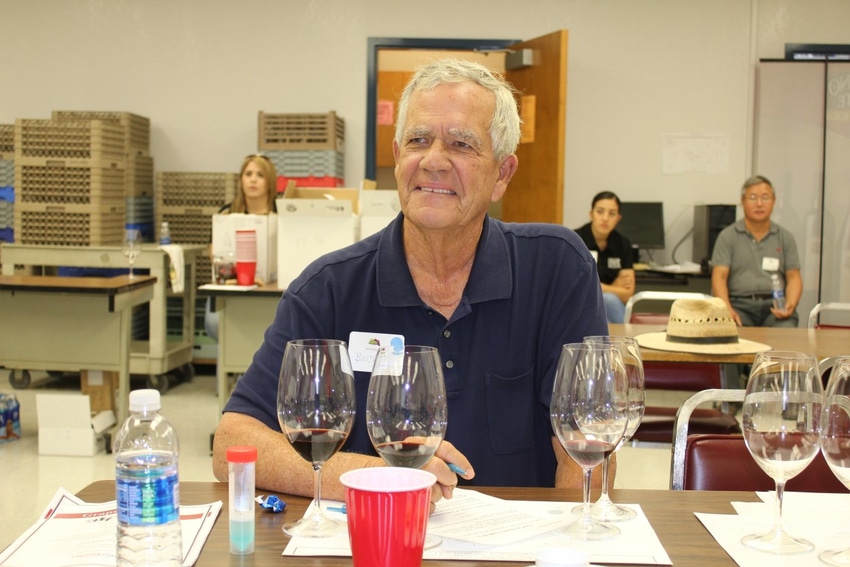
Grapes: Can audio playback interrupt GWSS mating?
USDA entomologist Rodrigo Krugner says insects communicate through seismic vibrational signals produced by their abdominal muscles.He's studying whether recorded “courtship signals” sent in call-response fashion (audio playback) can disrupt glassy-winged sharpshooter mating.
August 9, 2016

Unlike the Beach Boys musical group of old, Rodrigo Krugner is picking up bad vibrations.
It’s the sounds that glassy-winged sharpshooters make as they seek to find and mate with each other. That’s the focus of research by Krugner, research entomologist with the U.S. Department of Agriculture’s Agricultural Research Service in Parlier, Calif.
Krugner discussed “Mating disruption of the Glassy-Winged Sharpshooter: How does that sound?” at this year’s Grape Day event at California State University, Fresno (Fresno State). The insect can spread the deadly Pierce’s disease in grapevines faster than its smaller sharpshooter cousins, and Pierce’s costs California more than $100 million per year.
Krugner explained how the insects communicate with each other through seismic vibrational signals produced by their abdominal muscles. He is studying the degree at which “courtship signals” sent in call-response fashion can be disrupted.
Right now, the means for combatting the pest include insecticide applications in citrus orchards where they congregate, and releasing egg parasitoids.
Doppler vibrometer
Krugner explained that a laser Doppler vibrometer, a technology used in the aerospace industry to listen for vibrations, figured into his research. Both white noise and female calls reduced mating under laboratory conditions, but did not affect insect aggregation.
The efficacy of these and other signals in disrupting GWSS communication is being evaluated under field conditions in collaboration with Fresno State.
Electrodynamic shakers were attached to plant stems to generate disruptive and-or masking signals. The idea is to learn if the playback of selected GWSS signals onto grapevines will determine whether mating behavior is affected by disruptive signals and whether GWSS individuals can be either attracted or repelled by signals.
Krugner said males sometimes naturally mimic females to lure rivals away, and noted the process of mates locating each other often takes up to three hours.
Measuring grape rot
Other speakers at Grape Day included Roy Thornton, enology professor with Fresno State’s Department of Viticulture and Enology, who discussed on objective ways to measure rot in grapes.
Thornton, who will retire this year after 14 years with Fresno State, has long contended it’s virtually impossible to tell how much rot is in a load of grapes based on visual inspection.
For one thing, grapes with sour rot, a major culprit, can easily escape visual detection. So far, the best technology for quantifying the level of rotten grapes, he said, is the Fourier Transform Infrared Spectrometer.
But the determination of rot levels is not a simple one, Thornton share.
“You can’t say, for example, that because acid levels are X, it will mean X amount of rot,” he said.
Fresno State researchers have sought to measure rot levels in trials where they purposely inoculated grapes with three significant culprits - Aspegillus niger, Rhizopus stolonifera, or Penicillium italicum.
It appears they have met their greatest success in approximating rot levels on Chardonnay and White Zinfandel, both of which have thin skins. But the bottom line, Thornton said, is that there is no ‘gold standard’ for measuring grape rot.
A Thanksgiving SJV grape harvest?
Sanliang Gu, Fresno State viticulture professor, spoke on a new approach to growing wine grape in the San Joaquin Valley aimed at harvests in the late fall near Thanksgiving.
Gu posed several rhetorical questions, including “Who wouldn’t prefer harvesting when it’s 75 degrees?” and “Who does not want to grow Napa grapes in Fresno?”
His research aims at extending cool-season growth of certain varieties of grapes, most notably Cabernet Sauvignon.
“The best quality fruit ripens later,” Gu said.
The forcing of later fruit involves bud removal from newly-set berry clusters, plus pruning back shoots and removing leaves and laterals. In some cases, leaves can be retained to provide protection from sunburn.
When these actions are taken, a second bud break quickly follows and the whole developmental cycle starts anew, Gu said. And since the new cycle starts up to several weeks later, the fruit of the forced crop ripens later in the season, generally under cooler temperatures, with characteristics of cool-region, higher-value fruit.
Winemaking and glutathione
Matt Brain, winemaker at the Fresno State Winery, discussed the role of glutathione (GHS) in winemaking and reduced sulfur use.
He said the antioxidant plays an important role in protecting white and rose wines against oxidation, which is undesirable and leads to a loss of desired aromatics and decreased wine quality.
Researchers are looking at ways to maximize GHS and how this and sulfur dioxide work synergistically to preserve fresh wine aromas.
“Understanding how GSH levels impact aging curves will allow winemakers to safely reduce SO2 levels through aging and at bottling,” Brain said, “allowing the production of more expressive and desirable aromatics expressed during the wine sales and consumption time frame.”
It is very important, he said, that winemakers “understand the aging curve” to better align sales with peaks in quality and taste.
Portuguese corks
Elizabeth Ramey, a senior Fresno State Enology student, recounted her visit to Portugal to explore the manufacturing of cork and other closures.
Ramey visited a cork forest where cork is harvested from trees every 10 years or so, and Amorim factories where cork is processed. She also visited the Relvas capsule production facility where other bottle closures, including screw caps, are made.
Portugal produces half the world’s cork, and its government protects cork trees grown in the country. Of all the cork harvested by Amorim, 70 percent is rejected for products other than wine closures; 30 percent go into a bottle.
The company takes significant steps to reduce TCA, a chemical compound which can impart a tainted taste to wine.
It’s free – Western Farm Press Daily – agricultural news delivered to your Inbox.
You May Also Like



